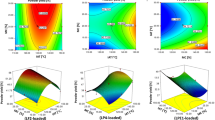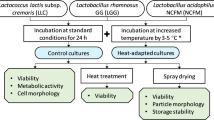Summary
A method to produce viable and stabile dry microorganisms for food and agricultural purposes was developed. Spray-dried, freeze-dried or liquid culture concentrates of lactic acid-producing bacteria were mixed with various bulking agents to form a homogeneous wet granulation having a water content of 35–60% (w/w). The wet granulation was extruded through a dye onto a spinning plate (350–500 rpm) of a spheronizing device which resulted in the formation of discrete spherical particles. After forming spheres, the aggregate cell particles, both coated and uncoated, were dried to a moisture level of 5–10% using a temperature below the microorganism's optimum growth temperature. The coated and uncoated products were stored at different temperatures and periodically sampled to determine stability. Uncoated cell particles were more stabile at 4°C than at 22°C for 76 days. While both coated (with sodium alginate or carboxymethyl-cellulose) and uncoated particles showed similar stability at 4°C, at higher storage temperatures the applied coating improved the storage stability of the culture particles.
Similar content being viewed by others
References
Espina, F. and V.S. Packard. 1979. Survival ofLactobacillus acidophilus in a spray-drying process. J. Food Prot. 42: 149–152.
Font de Valdez, G., G. Savoy de Giori, A. Pesce de Ruiz Holgado and G. Oliver. 1983. Comparative study of the efficiency of some additives in protecting lactic acid bacteria against freeze-drying. Cryobiology 20: 561–566.
Heckly, R.J., R.I. Dimmick and N. Guard. 1967. Studies on survival of bacteria rhythmic response of microorganisms to freeze-drying additives. Appl. Microbiol. 15: 1235–1239.
Jao, Y.C. and I.C. Good. 1985. Method for the preparation of spherical microorganism cell aggregates. United States patent No. 4, 543, 332.
Karel, M., O.R. Fennema and D.B. Lund. 1975. Principles of Food Science. Part II. Physical Principles of Food Preservation, p. 343, Marcel Dekker, Inc., New York.
Marshall, B.J., G.G. Coote and W.J. Scott. 1974. Some factors affecting the viability of dried bacteria during storage in vacuo. Appl. Microbiol. 27: 648–652.
Morichi, T. 1974. Preservation of lactic acid bacteria by freeze-drying. Japan Agric. Res. Q. 8: 172–176.
Olsen, N.F. and E.L. Magee. 1982. Preservation of cheese with microencapsulated enzymes. United States Patent No. 4,310,554.
Orndorff, G.R. and A.P. MacKenzie. 1973. The function of the suspending medium during the freeze-drying preservation ofEscherichia coli. Cryobiology 10: 475–487.
Porubcan, R.S. and R.L. Sellars. 1975. Stabilized dry cultures of lactic acid producing bacteria. United States Patent No. 3,897,307.
Silliker, J.H., C.H. Koonz, D. Grove and C.E. Janse. 1963. Drying of bacterial cultures. United States Patent No. 3,075,887.
Van Arsdel, W.B. and M.J. Epley. 1964. Food Dehydration. Vol II. Products and Technology, p. 627, AVI Publishing Co., Westport, CT.
Author information
Authors and Affiliations
Rights and permissions
About this article
Cite this article
Kim, H.S., Kamara, B.J., Good, I.C. et al. Method for the preparation of stabile microencapsulated lactic acid bacteria. Journal of Industrial Microbiology 3, 253–257 (1988). https://doi.org/10.1007/BF01569583
Received:
Revised:
Accepted:
Issue Date:
DOI: https://doi.org/10.1007/BF01569583




